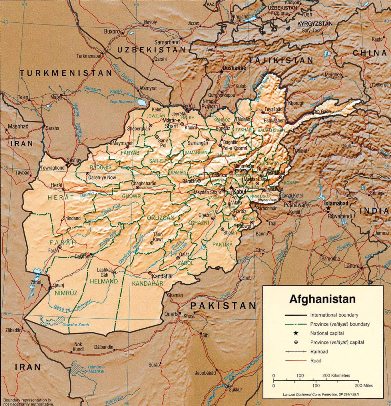Natural Regions of Afghanistan
High mountains cover much of Afghanistan, with about one-half of the land over 2000 m (6600 ft) in elevation. Small glaciers and year-round snowfields are common. The highest peak, Nowshak (Noshaq), rises 7485 m (24,557 ft) on the northeast border and is a lower spur of the Tirich Mir peak in Pakistan. The Hindu Kush range extends across the country in a southwesterly direction from the Vakhan Corridor almost to the Iranian border. From the Hindu Kush, other lower ranges radiate in all directions. Some of the major ranges include the Pamirs in the upper northeast of the Vakhan Corridor, the Badakhshan Ranges in the northeast, the Paropamisus Range in the north, and the Sefid Koh range, which forms part of the frontier between Afghanistan and Pakistan. Lowland areas are concentrated in the south and west and include the Turkistan Plains, the Herat-Ferah Lowlands of the extreme northwest, the Sistan Basin and Helmand River valley of the southwest, and the Rigestan Desert of the south. Except for the river valleys and a few places in the lowlands where underground fresh water makes irrigation possible, agriculture is difficult. Only about 15 percent of the land is suitable for farming. Moreover, a war with the Union of Soviet Socialist Republics (USSR) in the 1980s and the subsequent civil war in the 1990s left some of that land unusable because of neglect, the planting of explosive mines, and other problems. In general, sheep and goat grazing make up the main agricultural land use. In eastern and southeastern Afghanistan, forest lands amounted to about 2 million hectares (about 5 million acres), or about 4.5 percent of the country, before the war. The ravages of war, the scarcity of fuel, and the need for firewood for cooking and heating have caused rapid deforestation. Because Afghanistan has so many high mountains, the passes through them have been of profound importance in both the history of invasion of the country and in commerce. In the 320s BC Alexander the Great invaded the country through the Kushan Pass (about 4370 m/about 14,340 ft) in the west and left it to the east through the low Khyber Pass (920 m/3018 ft) to invade India. These same passes were used by the Mughal emperor Babur to conquer both Afghanistan and India in the 1500s. The famous Salang Pass (about 3880 m/12,720 ft) and its Soviet-built tunnel in the central Hindu Kush was one of the main routes the Soviets used to invade Afghanistan in 1979 |
SOME WORDS ABOUT AFGHANISTAN (my country)
Afghanistan, in southwestern Asia, bounded on the north by Turkmenistan, Uzbekistan, and Tajikistan; on the east by China and the part of the disputed territory of Jammu and Kashmir controlled by Pakistan; on the south by Pakistan; and on the west by Iran. Afghanistan was a monarchy from 1747 to 1973, when the king was overthrown by military officers and the country was proclaimed a republic; the republic dissolved in 1992 as the country erupted in civil war. Afghanistan lies across ancient trade and invasion routes from central Asia into India. This position has been the greatest influence on its history because the invaders often settled there. Today the population includes many different ethnic groups. Most of the present borders of the country were drawn up in the 19th century, when Afghanistan became a buffer state, or neutral zone, between Russia and British India. Kabul is the capital and largest city. Key Data Region: AsiaArea Total: 647,500 km2Area Land: 647,500 km2Coast Line: 0 km (Landlocked) kmCapital: Kabul Climate: Dry to semiarid; cold winters and hot summersLanguages:Pashto, Pashtu or Pukhto number of Speakers in Afghanistan approximately 14 million and Dari (Farsi) is spoken by almost every ethnic division, they are Indo-European languages and are the major two languages spoken in Afghanistan; other Indo-European, Indo-Aryan languages, such as Balochi, Pashayi and Eastern Farsi, are also spoken; Turkic and Altaic languages, such as Uzbek and Turkmen, are present; Tajiki is also used. Currency: AfghaniHoliday: Independence Day, 19 AugustBoundariesPakistan: 2,430kmTajikistan: 1,206kmIran: 936kmTurkmenistan: 744kmUzbekistan: 137kmChina: 76km
Ethnic Divisions Pashtun : 38%Tajiks : 18%Uzbek : 28%Hazara : 8%Turkmen : 4%Baloch7 : 3%Other :1% |
hsuleyman4000@yahoo.com
If you're interested in learning more about photography, click on the following link, and also visit my Favorite Links page www.afghanuz.com www.nawaye.org http://www.babur.org/ http://www.armagan.de/ www.anadolu.edu.tr www.junbish.org www.junbes.org www.afghanpaper.com www.mehmetsahin.net www.milliyet.com.tr for chat www.afghana.com www.mynet.com http://groups.yahoo.com/group/afganistan-turkgenclig www.onlinemuzik.be |

I CHOOSE ANADOLU UNIVERSITY BECAUSE OF?
Democratic and Modern Education
Having modern technological facilities and equipment, Anadolu University offers student-centered education in a democratic environment. The students find a lot of opportunities to take part in social and cultural activities with a participatory approach conforming to international standards and to express themselves in every arena. Experienced and Knowledgeable Academic Staff
More than 1600 teaching staff and some visiting professors, all experienced and knowledgeable in national and international arenas, carry out courses at Anadolu University with great enthusiasm. Well-Equipped Facilities
All the units at Anadolu University have the technical equipment necessary for modern education. All the laboratories, workshops and studios are equipped with the most advanced devices and tools required for practical education. It is also given a special importance to enrich the library collection. Intensive English Language Program
Anadolu University offers Intensive English Language Program to the students of almost all the departments on the basis of the consideration that knowing a foreign language is crucial for the integration of Turkey with the rest of the world and for the education of prospective leaders and administrators who will have important roles in the future of Turkey. The ultimate aim is to educate students as individuals knowing at least one foreign language and equipped with modern knowledge and considerable world knowledge. Quality Student Profile
Each year, more than 5000 students register at Anadolu University. More than half of this population consists of the students who are graduates of high schools in big cities such as Ankara, Ä°stanbul, EskiÅŸehir, Ä°zmir, Bursa and Antalya . The high schools they graduated from are considered outstanding educational institutions both in the cities they are located and nation-wide. Most of the students are graduates of high quality educational institutions such as Anatolian High Schools, Science High Schools and Foreign Language Medium High Schools.
|
